Focus on how your breasts look and feel.
The following are steps that will take you through a complete breast self exam:
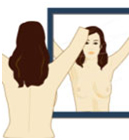
Arms Raised Above
Step 1: Stand in front of a large mirror and observe the size and shape of your breast. You will also need to pay attention to the color and texture.
Step 2: Now assess your breast by looking at mirror in four different postures:
• Both arms folded down.
• Both arms raised above your head.
• Both arms placed over your waist.
• Slightly bending down with arms over waist
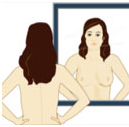
Arms placed over your waist
Step 3: Gently squeeze each nipple between your fingers and thumb and check for nipple discharge if any.
Step 4: Lying down flat, with a pillow under right shoulder feel your right breast with your left hand and your left breast with a pillow under left shoulder with your right hand.
Use the first few fingers of your hand, keeping the fingers flat and together. You can begin at the nipple, moving in larger and larger circles until you reach the outer edge of the breast.
You can also move your fingers up and down vertically, in rows, as if you were mowing a lawn. Be sure to feel all the breast tissue. Make sure that you cover the whole breast.
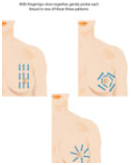
Pattern to cover the
whole breast
Step 5: Feel your breasts while you are standing or sitting. Many women find that it is easy to feel the breasts when it is wet and hence, prefer to do this while taking a bath.
The goal of a breast self-exam is for you to get used to the way your breasts look and feel. Knowing your breasts better will help you notice any abnormality immediately, so that necessary steps can be taken to prevent and/or correct them.
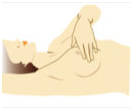
Lying down flat
What you should look for:
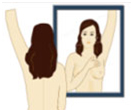
- Breast size, shape and color.
- Relative position of nipples on either side.
- Visible distortion or swelling.
If you see any of the following changes, bring them to your doctor's attention:
- Dimpling, puckering, or bulging of the skin.
- A nipple that has changed position or an inverted nipple (pushed inward instead of sticking out).
- Redness, rash, or swelling.
- Discharge of milky or yellow fluid or blood from your nipple.
A lump in your armpit.
|